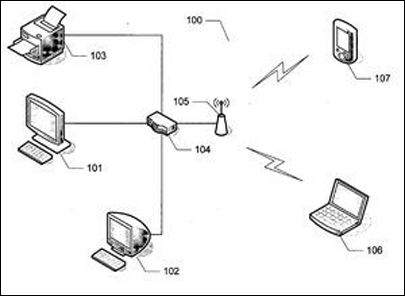The United States Patent and Trademark Office published a patent application this week, filed by Apple for what is described as an “RFID network arrangement.” The application lists Michael Culbert as the inventor and describes a system in which an RFID transceiver (interrogator) built into a Wi-Fi-enabled access point or base station, such as a wireless router, would read an RFID tag inside a network device, such as a computer or mobile device, to exchange data that would initiate a process for linking the wireless network device into a wireless computer network.
According to the patent application, such a system would be deployed as “a way to simplify the configuration of wireless network devices and access points.” While wireless networks are valuable tools, the application indicates, “many users, particularly home and small office users, lack the level of knowledge necessary to install and configure wireless network devices.” A second concern described in the application involves the low usage of data security protocol applications among wireless network users—especially among home and small-office users. The protocols exist but are often not utilized, it says, and networking equipment is generally shipped with the security features disabled. Not using security protocols makes wireless network users vulnerable to computer attacks.
To address these issues, the RFID technology application purports to offer “a system for simplifying the configuration of wireless network devices and minimizing the amount of traditional user interface required to do so, while still permitting users to employ robust authentication and encryption algorithms.”
To establish a network connection under the system described in the patent application, an RFID-tagged wireless network device would be brought within close proximity—roughly 1 foot—of the wireless base station. The base station’s RFID transceiver would then read the tag in the network device. Once communication was established, the transceiver would write to the tag various communication and security parameters (including authentication and encryption passwords) necessary for the network device to establish communication with the base station housing the RFID transceiver.
The network device would save these parameters in its internal memory, then use them to establish a link to the base station, employing what the application calls “the conventional radios and protocols (e.g., a Wi-Fi connection).” Thus, the user could establish a secure connection without having to configure a network device, or input any passwords or security codes.
The application also describes an alternate system in which the RFID tag would be read-only and the RFID transceiver in the base station would record the identifier encoded to the RFID tag. This tag could contain “sufficient information concerning the default communication parameters of the network device” to establish a connection with the wireless network device.
The application was filed with the U.S. Patent Office on Sept. 6, 2005, and describes a number of other configuration and deployment schemes as well. The full text is available here.
The patent application does not detail the type of identifier that would be encoded to the RFID tags, nor if transceivers other than those embedded in Apple base stations would be able to read it. The document also does not detail the frequency such an RFID system would use, though it does repeatedly claim it would have a short range of around 1 foot. Apple has not responded to RFID Journal‘s request for an interview to learn more about the patent and the company’s plans for commercialization around the technology.
Roger Kay, president of IT analyst firm Endpoint Technologies Associates, says the patent application appears to signal a move by Apple toward ingraining security into its wireless devices. “The main thing about this patent application is the ease of use and security [it would enable],” he explains. “What Apple is saying is, ‘People aren’t using security, and they should. And they will if we do all the configuration work for them.'”
According to Kay, the wireless network devices Apple users would want to add to a computer network in, say, a home setting, could include anything from a printer to an Apple iPhone. By making an iPhone a network device, a user might be able to transfer phone numbers from a computer-based address book to the phone.
Kay says it is also possible Apple is eyeing the RFID-based network configuration tool as a means of providing home network-based content sharing in an attempt to appease Hollywood studios concerned about copyright infringement. This, he adds, could be realized by allowing only devices authenticated as part of a home network to stream video or other media from that network. When Apple might deploy the technology, and in which of its devices, is not yet clear.


